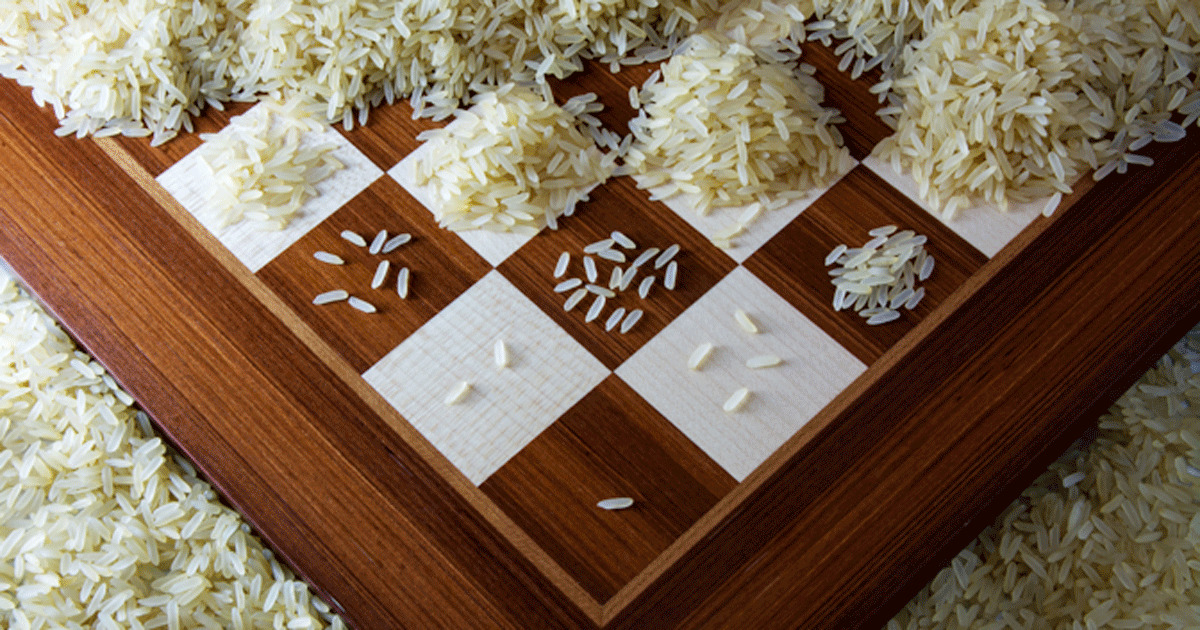In the book The Second Machine Age, MIT professors Andrew McAfee and Erik Brynjolfsson document the way in which technology and automation are changing our economy. And one particularly effective way they do it is through a story about a chessboard, rice, and Gordon Moore.
Gordon Moore is the cofounder of Intel and in the 1960s he made the incredibly prescient prediction that the amount of computing power one could buy for a dollar would double every year for the next decade. Aside from some quibbling about the exact time period of doubling, his prediction has remained largely true over the past five decades, not just one. This is known as Moore’s Law.
What repeated consistent digital doubling means, exactly, is best demonstrated through a story about an emperor and a chessboard. As legend has it, when chess was invented in sixth century India, the inventor was given an audience with the emperor. When asked to name his prize, the inventor asked for a single grain of rice to be placed on the first square of the chessboard, two to be placed on the second, four on the third, and so on, with the quantity of rice doubling every square. What most people, including the emperor, fail to realize is that if this pattern continues, by the final square the emperor would owe the inventor eighteen quintillion grains of rice, more rice than has been produced in the history of the world.
The chessboard example is a useful tool to think about the dramatic impacts of digital doubling. As the authors write, in the first half of the chessboard we can still imagine the quantities of rice: after 32 squares, the emperor owes 4 billion grains, a number we can conceptualize. It’s in the second half of the chessboard that the quantities quickly become unimaginable. And the authors argue that we’ve recently entered the second half of the chessboard.
The Second Half of the Chessboard
I was thinking about rice and the second half of the chessboard when I read the New York Times article last month The Great AI Awakening, documenting Google’s efforts to improve its Google Translate service. I highly recommend the entire article, but the summary is that things are quickly becoming unimaginable.
The old version of Google Translate relied on computer code written over a decade by hundreds of Google’s smartest engineers, which matched individual phrases in one language to another using a massive database of texts. The system was incredibly complex, but still worked off of algorithms constructed by Google engineers. And while the service was revolutionary, the phrase-by-phrase, rule-based system often produced translations that were clunky and awkward to native speakers.
Enter Google Brain. This elite team at Google created a “neural network” – essentially an effort to replicate the human mind in the digital space – that would learn the way a human does from her earliest years: through trial and error, experiencing successes and failure, identifying patterns, improving on its own. The goal was that Google Translate would no longer be relying on a set of rules written by humans, but that it would go off and learn on its own.
And it did. Over nine-months, the neural network that Google Brain created made advancements in the fluidity of translation that were off the charts, surpassing gains made by the previous system over its entire ten years of development.
This feels like the second half of the chessboard. Through advancements in technology and processing power, really smart people were able to create something in nine months that made the already amazing work of hundreds of other smart people, compiled over ten years, essentially obsolete.
The previous distinction in trying to figure out which jobs would be automated and which were safe was routine vs. complex: routine work, be it cognitive or manual, that could be broken down to a set of rules, would be automated; more complex knowledge work was safe for now.
But what we now see is that the set of rules machines can follow are now much broader, and in some cases they’re writing their own rules, identifying their own patterns, and moving into areas of work we thought were squarely in the human domain.
What does this mean for all of us?
For starters, no one can predict the future. But it seems the best way to prepare for this uncertain future is by getting as much and as broad an education as possible. “Unskilled” work, requiring only a high school degree, is rapidly being automated, and only more automation is promised. And even higher education too narrowly focused could lock one into a set of narrow skills that may soon be automated. Better, it seems, to seek a broad knowledge base, learn how to learn, and develop widely transferable skills in communication, critical thinking, and collaboration that can be applied to any job.
Things are already changing rapidly, and if we are in the second half of the chess board, things are just going to move faster. The education we all need is the one that will allow us to adjust to the changes we can’t yet imagine as we move to the next square.







